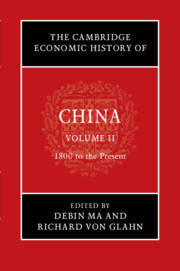Book contents
- The Cambridge Economic History of China
- The Cambridge Economic History of China
- The Cambridge Economic History of China
- Copyright page
- Contents
- Figures
- Maps
- Tables
- Contributors to Volume II
- Acknowledgments
- Note on Citations
- Introduction to Volume II
- Part I 1800–1950
- Part II 1950 to the Present
- 15 The Origin of China’s Communist Institutions
- 16 China’s Struggle with the Soviet Growth Model, 1949–1978
- 17 Living Standards in Maoist China
- 18 The Political Economy of China’s Great Leap Famine
- 19 China’s External Economic Relations during the Mao Era
- 20 The Chinese Economy in the Reform Era
- 21 China’s Great Boom as a Historical Process
- Index
- References
16 - China’s Struggle with the Soviet Growth Model, 1949–1978
from Part II - 1950 to the Present
Published online by Cambridge University Press: 07 February 2022
- The Cambridge Economic History of China
- The Cambridge Economic History of China
- The Cambridge Economic History of China
- Copyright page
- Contents
- Figures
- Maps
- Tables
- Contributors to Volume II
- Acknowledgments
- Note on Citations
- Introduction to Volume II
- Part I 1800–1950
- Part II 1950 to the Present
- 15 The Origin of China’s Communist Institutions
- 16 China’s Struggle with the Soviet Growth Model, 1949–1978
- 17 Living Standards in Maoist China
- 18 The Political Economy of China’s Great Leap Famine
- 19 China’s External Economic Relations during the Mao Era
- 20 The Chinese Economy in the Reform Era
- 21 China’s Great Boom as a Historical Process
- Index
- References
Summary
When the Communist Party of China announced a new government on October 1, 1949, the economy that government inherited was in shambles. China had been at war for over twelve years and much of the infrastructure of the country had been destroyed or badly damaged and prices were rising at 51 percent per month or 13,000 percent per year. The Guomindang government fleeing to Taiwan took much of the country’s foreign-exchange and gold reserves with them, along with many of the managers of the banks and industrial firms. Inflation and war left many of the businesses that stayed barely able to function even when their managers and technicians did not flee.
Keywords
- Type
- Chapter
- Information
- The Cambridge Economic History of China , pp. 565 - 605Publisher: Cambridge University PressPrint publication year: 2022



